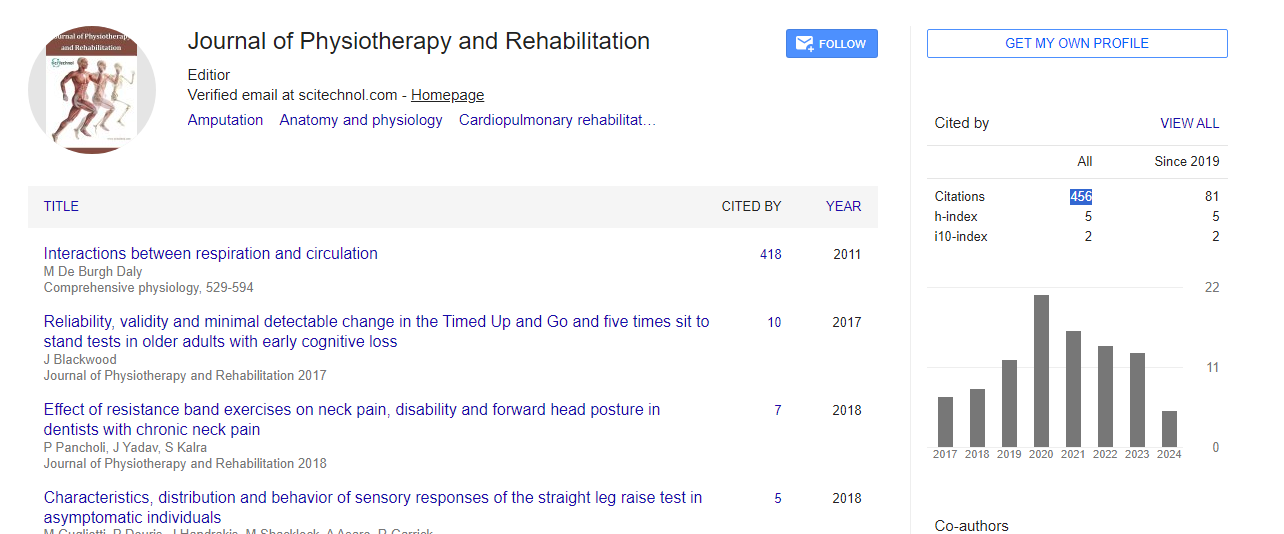Opinion Article, J Physiother Rehabi Vol: 8 Issue: 1
Pathways to Healing: Bio-Mechanisms Explored in Rehabilitation
Ayze Ran*
1Department of Physical Medicine and Rehabilitation, Ankara University, Ankara, Turkey
*Corresponding Author: Ayze Ran,
Department of Physical Medicine and
Rehabilitation, Ankara University, Ankara, Turkey
E-mail: mran@az.tr
Received date: 02 January, 2024, Manuscript No. JPTR-24-134582;
Editor assigned date: 04 January, 2024, PreQC No. JPTR-24-134582 (PQ);
Reviewed date: 18 January, 2024, QC No. JPTR-24-134582;
Revised date: 26 January, 2024, Manuscript No. JPTR-24-134582 (R);
Published date: 02 February, 2024, DOI: 10.4172/JPTR.1000156.
Citation: Ran A (2024) Pathways to Healing: Bio-Mechanisms Explored in Rehabilitation. J Physiother Rehabi 8:1.
Description
Rehabilitation is a multifaceted journey, marked by the exchange of biological mechanisms that facilitate healing and recovery. From the molecular level to the systems level, a multiple of processes come into play, each contributing to the restoration of function and the enhancement of quality of life for individuals undergoing rehabilitation. In this article, we explore the various pathways to healing within the realm of rehabilitation, shedding light on the biomechanisms that drive this transformative process.
At the beginning rehabilitation is the remarkable capacity of the body to regenerate and repair damaged tissues. Following injury or illness, a rapid of cellular events is initiated, aimed at restoring structural integrity and function. Stem cells, progenitor cells, and various growth factors coordinate the repair process, promoting tissue regeneration and remodeling. From the regeneration of muscle fibers to the rebuilding of damaged cartilage and bone, these cellular mechanisms lay the foundation for recovery and restoration of function.
Central to rehabilitation, especially in cases of neurological injury or impairment, is the concept of neuroplasticity-the brain's remarkable ability to reorganize and adapt in response to injury or changes in sensory input. Through targeted rehabilitation interventions, such as repetitive task training, sensory stimulation, and motor learning exercises, individuals can harness the plasticity of the nervous system to promote neural rewiring and functional recovery. This process allows for the restoration of lost abilities and the development of compensatory strategies to overcome deficits.
In addition to cellular and neural mechanisms, biomechanical adaptations play a critical role in rehabilitation. The body responds to changes in activity levels, loading patterns, and environmental stimuli by adapting its biomechanics to optimize function and minimize stress on injured tissues. Through targeted exercises, manual therapy techniques, and ergonomic modifications, individuals can improve movement patterns, restore joint mechanics, and enhance overall biomechanical efficiency. These adaptations not only support rehabilitation efforts but also help prevent future injuries and promote long-term musculoskeletal health.
The inflammatory response is a fundamental component of the healing process, serving to remove damaged tissue and initiate the repair rapid. In rehabilitation, the modulation of inflammation plays a important role in promoting tissue healing and minimizing secondary damage. Therapeutic interventions aimed at controlling inflammation, such as Cryotherapy, compression therapy, and pharmacological agents, can help manage pain, reduce swelling, and facilitate tissue remodeling. By optimizing the inflammatory response, rehabilitation specialists can enhance the efficiency of the healing process and expedite recovery.
Beyond the biological mechanisms, psychological and social factors also play a significant role in rehabilitation. Emotional wellbeing, social support, and motivation can profoundly influence an individual's ability to engage in rehabilitation and achieve positive outcomes. Addressing psychosocial factors through counseling, support groups, and motivational interventions can enhance adherence to treatment, improve coping strategies, and promote overall wellbeing during the rehabilitation process.
Conclusion
Rehabilitation is a dynamic and multifaceted journey guided by a complex interplay of bio-mechanisms that drive healing and recovery. From cellular regeneration and neural rewiring to biomechanical adaptations and inflammatory modulation, each pathway to healing contributes to the restoration of function and the improvement of quality of life for individuals undergoing rehabilitation. By understanding and limit these bio-mechanisms, rehabilitation specialists can optimize treatment outcomes and empower individuals to reach their full potential in the journey toward healing.
 Spanish
Spanish  Chinese
Chinese  Russian
Russian  German
German  French
French  Japanese
Japanese  Portuguese
Portuguese  Hindi
Hindi 